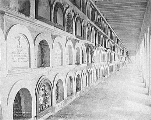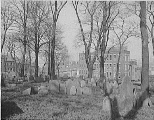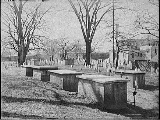Mourners opening the Chase family crypt in Christchurch, Barbadoes, are shocked to find that the coffins within have been overturned and scattered.
| 1813 | - Workmen at Windsor's St. George's Chapel accidentally break open the vault of Henry VIII and discover the coffin of Charles I inside, hidden after Charles II expropriated the money for a new sarcophagus.
|
| 1815 | - Eliza Fenning is executed for attempting to poison the family which employs her as a servant. Her funeral is one of the largest in London history as disbelieving sympathizers line the streets to pay their respects.
|
| 1817 | - The North-American Review prints an early version of William Cullen Bryant's poem Thanatopsis.
- The bodies of Abelard and Heloise are reunited at Paris's Pere Lachais cemetery.
- John Snar'ts Thesaurus of Horror describes various ways of avoiding premature burial.
|
| 1818 | - Mary Wollstonecraft Shelley tells the story of Frankenstein, a tale of a brilliant young scientist who carelessly reanimates a corpse.
- Edward Lillie Bridgman patents a wrought-iron coffin as a deterrent to resurrectionists. The lid proves to be susceptible to sledgehammer blows.
- The rediscovery of the remains of St. Francis of Assisi leads to the construction of an ornate, if inappropriate, tomb for the medieval champion of simplicity.
|
| 1821 | - Bachelor John Keats dies in his Rome. His body is buried by his friend, the painter Joseph Severn, who reserves the grave plot next to Keats for himself. Severn dies in 1879.
- A new Protestant Cemetery is opened in Rome after the Pope refuses to allow a wall to be built around the old one because that would obstruct the view from his palace.
- The Chase family of Barbadoes, frustrated by the repeated vandalism of their family crypt, move all the bodies to a new location. The disturbances cease. (See 1812).
|
| 1822 | - The body of Shelley is exhumed and cremated under the Tuscan Quarantine Law which requires the burning of anything washed up from the sea to prevent the spread of the plague.
- Edward John Trelawny arranges for Shelley's ashes to be buried in Rome's Protestant Cemetery. Trelawny selfishly reserves the adjacent grave for himself, forcing Mary Shelley to find another spot.
|
| 1824 | - An Edinburgh woman breaks the law and cremates her stillborn infant to avoid the bother and expense of a funeral.
- Connecticut passes an Anatomy Act, allowing doctors to procure corpses for dissection.
- Louis XVIII is the last French monarch interred in the manner of L'Ancien Regime.
|
| 1827 | - The tomb of Saints Cuthbert and Oswald is opened and the contents examined. Cuthbert's bones are reburied the following year, but his vestments, coffin, pectoral cross, and other secondary relics are retained by the monks who have reoccupied Durham. Oswald's head, removed after the battle of Maserfield (see 642) is also reburied.
|
| 1828 | - Sir Astley Cooper boasts to a select committee that he can procure any body he wishes to dissect, regardless of their station in life. He becomes known as "the King of the Resurrectionists".
- After George Washington's heirs refuse to exhume his body, Congress decides to fill the large crypt in the Capitol rotunda.
|
| 1829 | - William Burke, who killed his victims by "burking" (smothering by covering the nose and mouth while pressing on the chest) and then sold them to Dr. Robert Knox, is hanged, anatomized and put on display at Edinburgh University. His skin is tanned and sold as wallets and tobacco pouches. His accomplices, including Knox, evade prosecution.
- The British abolish suttee in India.
|
| 1830 | - Dr. John Collins Warren persuades the Massachusetts State Legislature to allow limited anatomical dissections.
- The poorly embalmed body of George IV nearly explodes his lead coffin.
|
| 1831 | - Thomas Williams, John Bishop, and John May kill three people for sale to the anatomists. Bishop and Williams are hanged and dissected. May is exiled to Australia.
- Aberdeen Magazine publishes Francis Clerihew's fictionalized account of his experiences as a resurrectionist.
- Mount Auburn Cemetery established in Cambridge, Massachusetts.
|
| 1832 | - English Parliament passes the Anatomy Act, which supplies doctors with cadavers for dissection.
- Josef Rosenbaum bequeaths the stolen skull of Franz Josef Haydn to the Austrian Institute of Pathology and Anatomy.
- Utilitarian philosopher Jeremy Bentham wills his body to science with the provision that it be made into an "Auto-Icon" which shall be displayed periodically. He appears at certain board meetings.
|
| 1833 | - Madame Tussaud moves her London wax museum to Baker Street and combines her collection with a display of implements of torture and other horrific oddities.
- Workmen at Taplow, Buckinghamshire, England uncover a barrow mound while clearing the foundation of a church. The church was evidentally built over this sacred burial site to erase vestiges of paganism.
|
| 1835 | - Carlo Baralino, designer of Genoa's Staglieno Cemetery, dies before his plans are realized.
- Pauline Jaricat, founder of the Association for the Propagation of the Faith, claims a miraculous cure that brings her back from the point of death when she is brought into the presence of the relics of Philomena. Pope Gregory XVI authorizes the Cult of St. Philomena consequent to Jaricat's testimony.
|
| 1836 | - Philadelphia imitates Boston by opening Laurel Hill Cemetery.
- Alessandro Regolini and Fr. Vincenzo Gallazi clear the contents out of a large, Etruscan tomb at Cerveteri, Italy in a mere twenty four hours.
|
| 1838 | - Richard the Lionheart's lead-encased heart turns up in Rouen, France.
- Not to be outdone by Boston and Philadelphia, Brooklyn opens Greenwood Cemetery.
|
| 1839 | - Angry mobs destroy Ohio's Worthington Medical College for its practice of using cadavers stolen from graveyards.
- Unknown rogues steal the heart of poet Paul Whitehead from a West Wycombe mausoleum. It is never recovered.
|
| 1840 | - The body of Napoleon Bonaparte is returned to Paris. More than 600,000 people, including King Louis Phillipe, line the street to watch his cortege pass.
|
| 1841 | - Edgar Allan Poe's The Murders in the Rue Morgue makes its first appearance in Graham's Magazine.
|
| 1843 | - Church officials declare that the body of virtuoso violinist and agnostic Niccolo Paganini (1782-1840) may be buried in consecrated ground. Genovese officials refuse to bury him, however, until 1896 because of rumors that Paganini made a Faustian pact in exchange for his genius.
|
| 1844 | - Staglieno Cemetery is established in Genoa, Italy.
- The coffin holding the remains of Revolutionary War advocate Thomas Paine are acquired from the estate of William Cobbett who had intended to raise a monument to the pamphleteer's memory. Instead, Paine's body is thereafter lost to history.
- Following their murder by an anti-Mormom lynch mob, the bodies of Joseph and Hyrum Smith are viewed by twenty thousand Mormons. Then after coffins filled with sand are publically buried in a Nauvoo, Illinois cemetery, the real bodies are concealed beneath the Nauvoo House hotel where they remain until Smith's widow reburies them years later.
- The Apocalypse, predicted to take place between March 21, 1843 and March 21, 1844 by William Miller, fails to occur. Nor does it make a second appointment on October 22 of the same year. Miller's followers, who go on to form The Seventh Day Adventists, call this "The Great Disappointment".
|
| 1847 | - Survivors of the Donner Party admit to cannibalism during their winter entrapment in California's Sierra Nevada.
- Death of Dr. Jacobus Kolletschka from a cut finger during an autopsy enables Dr. Ignaz Semmelweis to prevent puerperal peritonitis (childbed fever).
|
| 1849 | - The husband-wife team responsible for burials during Glasgow, Scotland's cholera epidemic seal bodies as soon as they are declared dead and refuse to open the coffins even if the "corpse" begins to kick and scream.
- The childless wives of King Thien Thi of Cochin, China are buried with him so that they can prepare his daily meals and provide for him.
- Edgar Allan Poe dies after completing his famous ode to necrophilia, Annabel Lee.
|
| 1850 | - Guérard tests water from a well in the l'Ouest cemetery and finds it to be potable.
- Openers of the tomb of St. Teillo (Llandaf Cathedral, Wales) discover an inventory of the tomb's contents made when it was previously opened in 1736.
- The Bab (Mirza 'Ali Mohammed -- his title means "Gateway") is executed by an Ottoman firing squad for treason. The first volley fails to injure him. The second kills him. His body is thrown into a ditch. A few years later, it is recovered by his Bahai followers and interred on Mount Carmel, Palestine.
|
| 1852 | - The Duke of Wellington's death is marked by grand memorial services in London and Austria-Hungary.
- The London Necropolis Company opens Brookwood Cemetery thirty miles outside the city. The cemetery has its own private railway and telegraph address.
|
| 1853 | - An American undertaker embalms a young suicide victim by draining it of its fluids and drying it on a board. The body is made a travelling exhibition and ends up in a Peoria, Illinois vault.
|
| 1855 | - The Duke of Sutherland holds a garden party to show off some new wickerwork which are touted for speeding up the process of decomposition.
|
| 1856 | - The New York Supreme Court affirms the right of the next-of-kin over the body.
- Frederick Law Olmstead models his Central Park after Brooklyn's Greenwood Cemetery.
|
| 1857 | - Flaubert's Madame Bovary shocks French literati with its painstaking portrayal of Emma's death by suicide.
|
| 1859 | - Tolstoi's Three Deaths is published.
|
| 1861 | - Embalmers begin assisting in the preservation and transportation of Union Civil War dead.
|
| 1862 | - After being wounded in the Battle of Chancellorsville, Stonewall Jackson's arm is amputated and buried on the farm of one Reverend Lacy. Jackson dies eight days later and is buried in Lexington, Virginia.
- Te Ua Haumene, founder of the Maori Pai Marire ("Good and Peaceful Religion") military order believes he has been visited by the Angel Gabriel and sacrifices his child to repent for the corruption of the Maori people.
|
| 1863 | - "Father of Modern Embalming", Dr. Thomas Holmes, patents his process for electroplating corpses.
|
| 1864 | - Philadelphia undertakers organize.
- The U.S. Army organizes the first Grave Registration Unit to make positive identification of Union soldiers killed in battle.
|
| 1865 | - Abraham Lincoln's funeral train allows mourners to view the departed at many stops between Washington D.C. and Springfield, Illinois.
|
| 1866 | - The head of Cardinal Richielieu is returned to the care of the French government by a descendant.
|
| 1867 | - August Wilhelm von Hofman discovers formaldehyde.
- Japan requires cremation of all those who have died of contagious diseases.
|
| 1868 | - Proposals to close down Parisian cemeteries are dropped after massive public outcry.
|
| 1869 | - Dante Gabriel Rossetti has his wife, Elizabeth Siddall (d.1862), disinterred so that he can retrieve the only manuscript of several poems.
- Brunetti conducts experiments in cremation.
- Positivist philosopher Dr. Robinet publishes his Paris sans cimetière in which he argues "Without a cemetery, there is no city."
|
| 1870 | - A empty monument to the dead of the Franco-Prussian war is erected in Pere Lachais.
- Twenty thousand people climb five flights of stairs to view the body of Victor Noir (Yvan Salmon), killed in an altercation with followers of Prince Pierre Bonaparte. Another hundred thousand accompany Noir to his Pere Lachais grave. Public sentiment over Noir's death forces Napoleon III to abdicate.
- An undertaker finds he cannot fit the body of Robert E. Lee into his coffin, so Lee is buried without his boots.
- The Schwartzenbergs, owners of the Kutnáa Hora Ossuary, commision Frantishek Rinta to arrange the bones decoratively. Thus is created one of the most bizarre funerary displays every rendered.
|
| 1871 | - The Communards make their last stand in Paris' Pere Lachais Cemetery.
|
| 1873 | - The Italian Brunetti exhibits his cremation apparatus in Vienna.
|
| 1874 | - Death registration is first required in the United Kingdom.
- Alfred G. Packer is convicted of cannibalism in Colorado.
- Positivist Pierre Lafitte declares cemeteries to be one of "the basic institutions of any society." He goes on to become a key defender of the nineteenth century's cult of the dead.
- Archaeologists excavating the cemetery at Domatilla, in Rome, open the tomb of the eunuch martyrs Nereus and Achilleus and find it empty.
|
| 1875 | - Baltimore citizens raise enough money to rebury the remains of Edgar Allan Poe. Walt Whitman joins those present at the exhumation.
|
| 1876 | - Dr. Francis Julius Le Moyne builds the first U.S. crematory in Washington, Pennsylvania. His first customer is an eccentric German nobleman.
- A gang of counterfeiters is thwarted in its attempt to seize the body of Abraham Lincoln and hold it for ransom.
- The family of wealthy department store owner Alexander T. Stewart learns of a plot to ransom his remains. They hire an armed sentry who guards the tomb for several months until the family decides the danger is past. The graverobbers then strike and steal Stewart's corpse.
|
| 1877 | - "Harry G. Romaine" contacts the Stewart family lawyers and demands a $200,000 ransom for the return of Alexander Stewart's remains. Lawyers and family members bargain him down to $20,000 and meet him one night on a dark road where he hands over a sack of bones and disappears, never to be seen again. The family reburies Alexander in a secure vault equipped with an alarm system beneath Long Island's Garden City Cathedral.
- Rev. Stephen Bowers writes of his exhumation of more than 5000 bodies on California's Santa Rosa Island.
- A Sydney, Australia cemetery refuses to erect a monument commemorating conjuror and self-professed spiritualist William Davenport. The monument features many accourtrements of the stage magician's act, including ropes, musical instruments, and a "magic" cabinet, all of which the cemetery's caretakers find to be inappropriate for hallowed ground.
|
| 1878 | - The body of Congressman John Scott Harrison, son of President William Henry Harrison and father of future President Benjarmin Harrison, is stolen by Dr. Henri Le Caron and his wife. A search party finds the body at the Ohio Medical College in Cincinatti. This incident persuades many states to pass laws making it easier for medical schools to procure cadavers.
- A marble tablet turns up in Nazareth bearing a Roman inscription threatening capital punishment for tomb robbers.
|
| 1879 | - The Germans build the first modern crematorium at Gotha.
- First English crematorium built.
- French engineers and scientists dismiss fears of contamination from cemeteries as wholly "imaginary".
- The final resting place of Jamal Al-Din Al-Afghani is kept a secret due to his role in instigating the 1896 assassination of Nasir Al-Din Shah, ruler of Iran.
|
| 1881 | - Thieves kidnap the corpse of Alexander William Lindsay, the Fifth Earl of Crawford and Balcarres. They demand £6000 ransom which is not paid. The body is later recovered.
- Death of New Orleans "Voodoo Queen" Marie Laveau. She is buried in St. Louis Cemetery No. 1. Her crypt becomes a place of pilgrimage for those seeking her supernatural intercession.
|
| 1882 | - The Philadelphia Press exposes a grave-robbing ring which includes many prominent doctors and cemetery overseers.
- The wall surrounding the Jewish section at Pere Lachais is razed.
- Charles Souter is convicted of complicity in the stealing of the body of the Earl of Crawford. Souter, who showed authorities where the body was found, insists that he was poaching on the Earl's land when he met the real thieves. They are never apprehended. When Souter dies in 1914, he continues to deny that he was an accomplice.
- The U.S. Supreme Court rules that a cemetery company is an association formed for "a pious and public use".
|
| 1883 | - Guilty Parisians dedicate the eastern wall of Pere Lachais where the last Communards were executed (the Mur des Fédérés) as a memorial.
|
| 1884 | - British courts declare that cremation is legal.
- The Paris Municipal Council ends the leasing of graves in Pere Lachais Cemetery.
|
| 1885 | - All of Paris turns out for the funeral of novelist Victor Hugo.
- The bones of Virginia Clemm Poe are reburied with her husband Edgar. William Fearing Gill, an early admirer of Poe, has kept the bones under his bed ever since the graveyard where she was originally buried was covered over by developers.
- A small coffin containing the bones of a young woman is found in the north wall of a Folkestone church. They are assumed to be the relics of St. Eanswyth, who died in 640.
|










